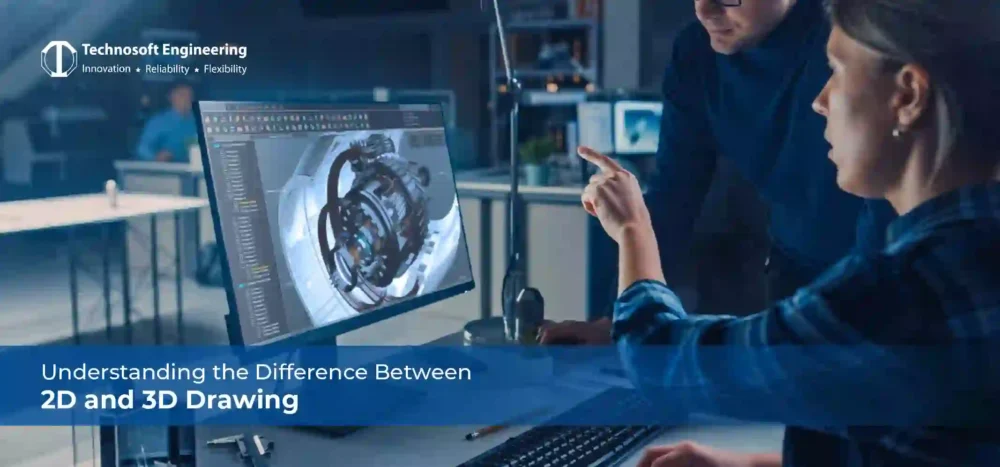
In the world of design and engineering, understanding 2D and 3D drawing is very basic. These two methods serve as the backbone of visual designing, each offering a unique application. In today’s blog, we will understand the definitions, differences, advantages, and disadvantages of 2D and 3D drawings that offer a comprehensive idea.
What is 2D Drawing?
A 2D drawing represents any object using length and width, lacking depth. Traditionally the designs were executed with pencil and paper, modern 2D drawings are drawings are usually done CAD (Computer Aided Design) software, such as AutoCAD. These drawings have lines, arcs, and other geometric elements to determine the shapes and layouts.
In mechanical engineering, 2D drawings are important for expression design processes and making sure all the features of the desired products are visible. They help for better communication among engineers, designers, and providing a clear visualization assemblies and elements. In addition, 2D drawings are important for creating tech documentation, which includes blueprints or schematics.
What is 3D Modeling?
A 3D (three-dimensional) drawing, or a model, is an object with length, width, and depth. It looks more realistic when viewed. It is created using 3D modeling software like SolidWorks or Autodesk Inventor, these drawings allow for the examining the object’s geometry from multiple angles.
3D drawings are crucial in different industries, such as architecture, automotive, aerospace, etc. These drawings help designers simulate real-world situations and examine the complete functionality before physical prototypes are manufactured.
This capability improves the accuracy of designs and helps identify potential problems early in the development process.
2D vs 3D: Key Differences
Dimensionality: 2D drawings only display the length and width, but 3D models shows depth, providing a more real life representation.
Visualization: 3D drawings or models provide a complete look at the object, which allows for rotation and viewing from different angles. In contrast, 2D drawings need multiple perspectives (e.g., front, top, side) to convey the same information.
Complexity: Building a 3D drawing is complex and time consuming than 2D drawings because there is additional dimension and complexity involved.
Software and Tools: 2D drawings can be made quickly and require basic tools or simply just CAD software, while 3D drawings mandate advanced modeling software.
Application: 2D drawings are usually used for technical documentation and for simple layouts, whereas 3D drawings are used to understand the detailed analysis and simulation.
Pros and Cons of 3D Printing
2D Drawings
Pros:
- Simplicity: Easy to make and understand because it has straightforward designs.
- Cost-Effective: Requires less advanced software, reducing costs.
- Standardization: Commonly used in various industries, making them a standard documentation.
Cons:
- Limited Visualization: Lacks depth and makes it difficult to visualize the model.
- Multiple Views Needed: The drawings needed are multiple as they must be different angles, which can cause misinterpretation.
- Inadequate for Simulation: It cannot be real life, like giving simulations or analyses that need detailed information.
3D Drawings
Pros:
- Enhanced Visualization: Gives a realistic view of the product, which makes understanding easy.
- Simulation and Analysis: This allows testing and analysis in a virtual process, decreasing the need for physical prototypes.
- Improved Communication: Provides clear and detailed representations, helping in effective communication among stakeholders.
Cons:
- Complexity: Needs specialized skills to create the 3D models.
- Higher Costs: It requires high-quality advanced software and hardware that increases the overall costs.
- Time-Consuming: It requires more time to build a real-life structure than a basic 2D drawing.
Conclusion
Now you know why is it important to understand the Difference between 2D and 3D drawing; it is for selecting the exact method your representation of your project. While 2D drawings provide a budget friendly and straightforward designs, 3D drawings provide depth with realistic features.
At Technosoft Engineering, our team is experienced in both 2D and 3D drawing services. We tailor to meet your exact requirements. Our team of experts uses the latest tools and technologies for delivering exact designing solutions. If you have a new product or you just want to fine tune the design, our engineering solutions are here to support what you need.
Need engineering or designing solutions, why wait? Contact Technosoft Engineering right away to understand how our 2D and 3D drawing services can boost your projects.